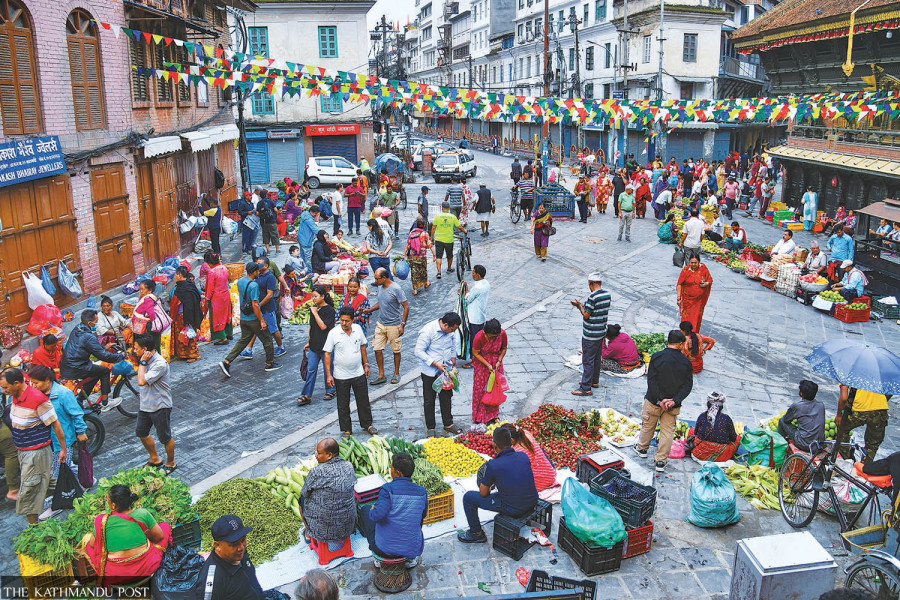Money
Food prices mirror past highs despite drop in inflation
Nepal’s central bank updates consumer price index base year to 2023-24.
Post Report
The year-on-year consumer price inflation stood at 4.1 percent in mid-August compared to 7.52 percent a year ago, nearly half, as non-food and service inflation dived to just 2.94 percent.
Experts say this is expected in rapidly growing low-income countries, as people with rising incomes consume more food and drive up food prices relative to the prices of other goods.
According to the central bank report released on Thursday, the food and beverage inflation stood at 6.17 percent in the review month.
Under the food and beverage category, the year-on-year price index of the vegetable sub-category increased 19.07 percent, pulses and legumes 12.09 percent, cereal grains and their products 9.15 percent, and milk products and eggs 3.66 percent.
Nepal Rastra Bank said it updated the consumer price index (CPI) base year to 2023-24. Before this, the base year was 2014-15.
In the updated consumer price index, the weight for the food and beverage group is 35.49 percent, and for the non-food and services group is 64.51 percent. In the base year 2014-15, the total weight of the food and beverage group was 43.91 percent, while the total weight of the non-food and services group was 56.09 percent.
So, according to analysts, a drop in non-food and services groups pulls the overall inflation.
As a result, the public doesn’t believe in the overall inflation rate worked out by the central bank as they say foods have become very expensive.
“That’s a wrong statement,” said Ramu Paudel, spokesperson for the Nepal Rastra Bank. “We calculate inflation with our methodology.”
Manbar Singh Khadka, an economist at the Asian Development Bank, said on Tuesday that since nearly 60 percent of Nepal’s imports are from India, the Indian price index is appropriate for comparison with Nepal’s consumer price index.
“As transportation costs are added, Nepal has a slightly high inflation rate.”
In India, inflation eased from 3.55 percent in July 2024 to 3.26 percent in August. In Nepal, it increased slightly, from 3.57 percent in mid-July to 4.1 percent in mid-August.
Nepal has an open border with India, facilitating the free movement of goods, and a hard peg to the Indian rupee. Thus, inflation shocks from India are transmitted to Nepal through trade and exchange rate channels.
Even though Nepal tries to retain domestic monetary control to some extent at the expense of financial openness, having a fixed exchange rate and an open border limits the policy's response to inflationary pressures, according to the International Monetary Fund.
According to the central bank, the updated index puts alcoholic drinks, tobacco products, and restaurants and hotels in the non-food and services group in accordance with the Classification of Individual Consumption by Purpose 2018 standard.
The prices of 525 items are collected from a weighted basket of 249 commodities to compute the price index. Of these, the prices of 59 items are recorded weekly, 94 monthly, and 372 quarterly.
For the first time, the central bank has computed the price index at the provincial level. Eighty-seven market centres have been selected for data collection across all 77 districts, including 28 from the Tarai, 43 from the hills, and 16 from the mountain region. Among these, 21 are rural market centres while 66 are urban. These market centres number 15 in Koshi, 12 in Madhesh, 16 in Bagmati, 11 in Gandaki, 13 in Lumbini, and 10 in Karnali and Sudurpaschim.
According to the new inflation data, consumer prices remain high in the Sudurpaschim province at 6.69 percent, while the Karnali province recorded the lowest at 3.46 percent in mid-July to mid-August.
“As the updated index has added new goods with price data from all 77 districts, the inflation report will be more representative and inclusive,” said Paudel. “Also, the goods on the index include their consumption by all income groups.”
No theory says that the inflation in the market and the inflation report of the central bank should match, Paudel argues. Before the update, the central bank collected data from 50 districts.




 12.99°C Kathmandu
12.99°C Kathmandu












%20(1).jpg&w=300&height=200)
